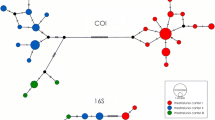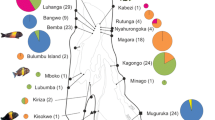Abstract
Genetic diversity patterns around the North Pacific received attention for marine organisms and have been used to infer biodiversity “hotspots” in the region. We conducted a phylogeographic study of the red alga Gloiopeltis furcata, investigating cryptic species diversity and comparing population genetic structure in the north Pacific. A phylogenetic tree and haplotype networks were constructed on the basis of 201 mitochondrial COI-5P sequences and 149 plastid rbcL sequences from G. furcata specimens. Eight distinct cryptic lineages (A–H) were identified within G. furcata. These lineages showed high genetic diversity and complex geographic distributions. All eight lineages of G. furcata sensu lato were present in the NW Pacific; however, only a single lineage (A) was present in the NE Pacific, suggesting that the NW Pacific is a center of genetic diversity for G. furcata sensu lato. Habitat discontinuities of G. furcata sensu lato in the high rocky intertidal zone may have been responsible for the high level of genetic differentiation of G. furcata sensu lato in the NW Pacific by impeding genetic exchange between adjacent populations. Our phylogenetic diversity suggests that the NW Pacific, especially Jeju Island, was a genetic diversity hotspot involving species diversity of Gloiopeltis.




Similar content being viewed by others
References
Bringloe T, Saunders GW (2018) Mitochondrial DNA sequence data reveal the origins of postglacial marine macroalgal flora in the Northwest Atlantic. Mar Ecol Prog Ser 589:45–58
Boo GH, Lindstrom SC, Klochkova NC, Yotsukura N, Yang EC, Kim HG, Waaland JR, Cho GY, Miller KA, Boo SM (2011) Taxonomy and biogeography of Agarum and Thalassiophyllum (Laminariales, Phaeophyceae) based on sequences of nuclear, mitochondrial, and plastid markers. Taxon 60:831–840
Cheang CC, Chu KT, Ang PO (2010) Phylogeography of the marine macroalga Sargassum hemiphyllum (Phaeophyceae, Heterokontophyta) in northwestern Pacific. Mol Ecol 19:2933–2948
Cox LN, Zaslavskaya NI, Marko PB (2014) Phylogeography and trans-Pacific divergence of the rocky shore gastropod Nucella lima. J Biogeogr 41:615–627
Coyer JA, Hoarau G, Schaik JV, Luijckx P, Olsen JL (2011) Trans-Pacific and trans-Arctic pathways of the intertidal macroalga Fucus distichus L. reveal multiple glacial refugia and colonizations from the North Pacific to the North Atlantic. J Biogeogr 38:756–771
Darriba D, Taboada GL, Doallo R, Psada D (2012) jModelTest 2: more model, new heuristics and parallel computing. Nat Meth 9:772
Excoffier L, Laval G, Schneider S (2005) Arlequin version 3.0: an integrated software package for population genetics data analysis. Evol Bioinform 1:47–50
Gavio B, Fredericq S (2002) Grateloupia turuturu (Halymeniaceae, Rhodophyta) is the correct name of the non-native species in the Atlantic known as Grateloupia doryphora. Eur J Phycol 37:349–360
Guindon S, Gascuel O (2003) A simple, fast and accurate method to estimate large phylogenies by maximum-likelihood. Syst Biol 52:696–704
Guiry MD, Guiry GM (2019) AlgaeBase. World-wide electronic publication, National University of Ireland, Galway. Available at: http://www.algaebase.org (last accessed 5 January 2019)
Hebert PDN, Cywinska A, Ball SL, deWaard JR (2003) Biological identifications through DNA barcodes. Proc R Soc Lond B 270:313–321
Hu ZM, Uwai S, Yu SH, Komatsu T, Ajisaka T, Duan DL (2011) Phylogeographic heterogeneity of the brown macroalga Sargassum horneri (Fucaceae) in the northwestern Pacific in relation to late Pleistocene glaciation and tectonic configurations. Mol Ecol 20:894–3909
Hu ZM, Li JJ, Sun ZM, Oak JH, Zhang FP, Grant WS, Duan DL (2015) Phylogeographic structure and deep lineage diversification of the red alga Chondrus ocellatus Holmes in the Northwest Pacific. Mol Ecol 24:5020–5033
Hu ZM, Li JJ, Sun ZM, Gao X, Yao JT, Choi HG, Endo H, Duan DL (2017) Hidden diversity and phylogeographic history provide conservation insights for the edible seaweed Sargassum fusiforme in the Northwest Pacific. Evol Appl 10:366–378
Ilves KL, Taylor EB (2008) Evolutionary and biogeographical patterns within the smelt genus Hypogesus in the North Pacific Ocean. J Biogeogr 35:48–64
Kelly RP, Palumbi SR (2010) Genetic structure among 50 species of the northeastern Pacific rocky intertidal community. PLoS One 5:e0008591
Kim MS, Kim SY, Nelson W (2010) Symphyocladia lithophila sp. nov. (Rhodomelaceae, Ceramiales), a new Korean red algal species based on morphology and rbcL sequences. Bot Mar 53:233–241
Kim KM, Hoarau GG, Boo SM (2012) Genetic structure and distribution of Gelidium elegans (Gelidiales, Rhodophyta) in Korea based on mitochondrial cox1 sequence data. Aquat Bot 98:27–33
Kumar S, Stecher G, Tamura K (2016) MEGA7: molecular evolutionary genetics analysis version 7.0 for bigger datasets. Mol Biol Evol 33:1870–1874
Le Gall L, Saunders GW (2010) DNA barcoding is a powerful tool to uncover algal diversity: a case study of the Phyllophoraceae (Gigartinales, Rhodophyta) in the Canadian flora. J Phycol 46:374–389
Lee JW, Oh BG, Lee HB (1996) Morphological variation of Gloiopeltis furcata (Postels et Ruprecht) J. Agardh (Rhodophyta) in the East Coast of Korea. Algae 11:91–94
Lee YP (2008) Marine algae of Jeju. Academy Publication, Seoul pp. [i]-xvi, 1-477 [2], map
Lee KM, Boo GH, Riosmena-Rodrigue R, Shi JA, Boo SM (2009) Classification of the genus Ishige (Ishigeales, Phaeophyceae) in the North Pacific Ocean with recognition of Ishige foliacea based on plastid rbcL and mitochondrial cox3 gene sequences. J Phycol 45:905–913
Lee KM, Yang EC, Coyer JA, Zuccarello GC, Wang WL, Choi CG, Boo SM (2012) Phylogeography of the seaweed Ishige okamurae (Phaeophyceae): evidence for glacial refugia in the northwest Pacific region. Mar Biol 159:1021–1028
Leliaert F, Payo DA, Gurgel CFD, Shils T, Draisma SGA, Saunders GW, Kamiya M, Sherwood AR, Lin SM, Huisman JM, Le Gall L, Anderson RJ, Bolton JJ, Matti L, Zubia M, Spoke T, Viera C, Payri CE, Coppejans E, D'hondt S, Verbruggen H, De Clerck O (2018) Patterns and drivers of species diversity in the Indo-Pacific red seaweed Portieria. J Biogeogr 2018:1–15
Librad P, Rozas J (2009) DnaSP V5: a software for comprehensive analysis of DNA polymorphism data. Bioinformatics 25:1451–1452
Lindstrom SC (2008) Cryptic diversity and phylogenetic relationships within the Mastocarpus papillatus species complex (Rhodophyta, Phyllophoraceae). J Phycol 44:1300–1308
Lindstrom SC, Hughey J, Martone P (2011) New, resurrected and redefined species of Mastocarpus (Phyllophoraceae, Rhodophyta) from the northeast Pacific. Phycologia 50:661–683
López BA, Tellier F, Retamal-Alarcón JC, Pérez-Araneda K, Fierr AO, Macaya EC, Tala F, Thiel M (2017) Phylogeography of two intertidal seaweeds, Gelidium lingulatum and G. rex (Rhodophyta: Gelidiales), along the South East Pacific: patterns explained by rafting dispersal? Mar Biol 164:188
Miller KG, Wright JD, Fairbanks RG (1991) Unlocking the ice house: Oligocene-Miocene Oxygen isotopes, eustasy, and margin erosion. J Geophys Res 96:6829–6848
Montecinos A, Broitma BR, Faugeron S, Haye PA, Tellier F, Guillemin ML (2012) Species replacement along a linear coastal habitat: phylogeography and speciation in the red alga Mazzaella laminarioides along the south east Pacific. BMC Evol Biol 12:97
Muangmai N, von Ammon I, Zuccarello GC (2016) Cryptic species in sympatry: non-random small-scale distribution patterns in Bostrychia intricata (Ceramiales, Rhodophyta). Phycologia 55:424–430
Oh BG, Lee HB (1996) Morphology of three species of Gloiopeltis (Endocladiaceae, Rhodophyta) in Korea. Algae 11:81–90
Okamura K (1927) Icones of Japanese algae. Kazamashobo, Tokyo Vol. V pp. 135-180, plates CCXXXVI-CCXLV
Otofuji YI, Kambara A, Matsuda T, Nohda S (1994) Counterclockwise rotation of Northeast Japan: Paleomagnetic evidence for regional extent and timing of rotation. Earth Planet Sci Lett 121:503–518
Palumbi SR (1994) Genetic divergence, reproductive isolation, and marine speciation. Annu Rev Ecol 25:547–572
Payo DA, Leliaert F, Verbruggen H, D’hondt S, Calumpong HP, De Clerck O (2013) Extensive cryptic species diversity and fine-scale endemism in the marine red alga Portieria in the Philippines. Proc R Soc B 280:20122660
Postels A, Ruprecht F (1840) Illustrationes algarum in itinere circum orbem jussu imperatoris Nicolai I. Atque auspiciis navarchi Friderici Lütke annis 1826, 1827, 1828 et 1829 celoce Seniavin exsecuto in Oceano pacifico, inprimis septemtrionale ad littora rossica asiatico-americana collectarum. Typis Eduardi Pratz, Petropoli [St. Petersburg] pp. [i-vi ], [i]- iv, 1-28 [1-2, index], [Latin:] [−iv], [1]-22, [1-2, index], 40 pls
Saunders GW, McDevit DC (2012) Acquiring DNA sequence data from dried archival red algae (Florideophyceae) for the purpose of applying available names to contemporary genetic species: a critical assessment. Botany 90:191–203
Sievers F, Wilm A, Dineen D, Gibson TJ, Karplus K, Li W, Lopez R, McWilliam H, Remmert M, Söding J, Thompson JD, Higgins DG (2011) Fast, scalable generation of high-quality protein multiple sequence alignments using Clustal Omega. Mol Syst Biol 7:539
Stamatakis A (2006) RAxML-VI-HPC: maximum likelihood-based phylogenetic analyses with thousands of taxa and mixed models. Bioinformatics 22:2688–2690
Tronholm A, Sansón M, Afonso-Carrillo J, Verbruggen H, De Clerk O (2010) Niche partitioning and the coexistence of two cryptic Dictyota (Dictyotales, Phaeophyceae) species from the Canary Islands. J Phycol 46:1075–1087
von der Heydt A, Dijkstra HA (2006) Effect of ocean gateways on the global ocean circulation in the late Oligocene and early Miocene. Paleoceanography 21:PA1011
Yang EC, Lee SY, Lee WJ, Boo SM (2009) Molecular evidence for recolonization of Ceramium japonicum (Ceramiaceae, Rhodophyta) on the west coast of Korea after the last glacial maximum. Bot Mar 52:307–315
Yang MY, Macaya EC, Kim MS (2015) Molecular evidence for verifying the distribution of Chondracanthus chamissoi and C. teedei (Gigartinaceae, Rhodophyta). Bot Mar 58:103–113
Yang MY, Kim MS (2018) DNA barcoding of the funoran-producing red algal genus Gloiopeltis (Gigartinales) and description of a new species, Gloiopeltis frutex sp. nov. J Appl Phycol 30:1381–1392
Zheng J, Chen Y, Yao F, Chen W, Shi G (2012) Chemical composition and antioxidant/antimicrobial activities in supercritical carbon dioxide fluid extract of Gloiopeltis tenax. Mar Drugs 10:2634–2647
Zuccarello GC, West JA (2003) Multiple cryptic species: molecular diversity and reproductive isolation in the Bostrychia radicans/B. moritziana complex (Rhodomelaceae, Rhodophyta) with focus on North American isolates. J Phycol 39:948–959
Acknowledgments
We thank Dr. G. W. Saunders, Dr. Olga Selivanova and Dr. Zhong-Min Sun for providing samples from Canada, Kamchatka and China, and all members of the molecular phylogeny team of the marine algal laboratory at Jeju National University.
Funding
This research was supported by the National Research Foundation of Korea (NRF) funded by the Ministry of Science, ICT and Future Planning (2017R1A2B4009420), Basic Science Research Program funded by the Ministry of Education (2019R1A6A1A10072987) of the Republic of Korea, and the 2019 scientific promotion program funded by Jeju National University.
Author information
Authors and Affiliations
Corresponding author
Ethics declarations
Conflict of interest
The authors declare that they have no conflict of interest.
Additional information
Publisher’s note
Springer Nature remains neutral with regard to jurisdictional claims in published maps and institutional affiliations.
Rights and permissions
About this article
Cite this article
Yang, M.Y., Yang, E.C. & Kim, M.S. Genetic diversity hotspot of the amphi-Pacific macroalga Gloiopeltis furcata sensu lato (Gigartinales, Florideophyceae). J Appl Phycol 32, 2515–2522 (2020). https://doi.org/10.1007/s10811-019-02017-y
Received:
Revised:
Accepted:
Published:
Issue Date:
DOI: https://doi.org/10.1007/s10811-019-02017-y




